Why Do Communities Recover Differently after Socio-Natural Disasters? Pathways to Comprehensive Success of Recovery Projects Based on Bam’s (Iran) Neighborhoods’ Perspective
Abstract
:1. Introduction
2. Materials and Methods
2.1. Research Setting
2.2. Data Collection
2.2.1. Identification of Conditions and Outcomes
2.2.2. Neighborhood Assessment
2.3. Data Analysis
2.3.1. Calibration Rubrics
2.3.2. Fuzzy-Set Qualitative Comparative Analysis (fsQCA)
3. Identification and Interpretation of Success and Failure Pathways of the Outcomes
3.1. Resilient Society (A1)
3.2. Sustainable and Resilient Built Environment (A2)
3.3. Resilient Economy (A3)
3.4. Comprehensive and Long-Lasting Success of SNDR Projects Per Community Perspectives (Main Objective)
4. Conclusions
- The research findings illustrate the determinant role of public engagement and emergency response in the recovery process. Public engagement played a vital role in achieving a resilient society, sustainable and resilient built environment, resilient economy, and long-lasting recovery success per community perspectives. However, the emergency response showed a strong link with successfully achieving a resilient society and long-lasting recovery per community perspectives. Moreover, the analysis of the success and failure pathways of successful long-lasting recovery per the residents’ view illustrated the importance of public engagement. Communities provided with sufficient emergency and transitional response did not experience comprehensive recovery years after the disaster unless people actively participated in the recovery process. This finding emphasizes the need for active engagement of all people in all phases of recovery. However, as discussed by some researchers, community engagement in the recovery process should be conducted under the clear guidance of governments to balance the impact on results [6,18].
- Individual factors have an impact on the success of a project. However, a combination of sufficient emergency response (rescue and health service), adequate response through to the transitional phase (shelter availability and living duration in permanent houses and shelters), climatically and culturally designed houses, and enhanced public strength through financial aid and disaster training, could achieve recovery success. The Fakhr Abad neighborhood, presenting the mentioned pathway, achieved full economic, social, and built environment recovery and ranked as a successful project per the residents’ perspectives. Therefore, it is necessary to provide sufficient answers to all the recovery phases, from rescue operations to public capability enhancement.
- One of the most interesting findings of this study is the significant role of housing design. Cultural housing design has been recognized as a crucial parameter affecting the satisfaction of residents [47]. Since shared living and working places are commonly seen in rural neighborhoods, it is necessary to consider the needs of people in housing design to avoid affecting their livelihoods [3]. The results of this study reveal that reasonable housing design is a necessary condition to achieve all four outcomes. Moreover, on the other hand, the climatically and culturally designed houses guaranteed recovery success based on Bam’s neighborhoods. On the other hand, the recovery project failed to reach all the outcomes in neighborhoods with inappropriately designed houses.
Author Contributions
Funding
Institutional Review Board Statement
Informed Consent Statement
Data Availability Statement
Acknowledgments
Conflicts of Interest
Appendix A. Calibration Rubrics
| Conditions’ Calibration Rubrics | |||||
|---|---|---|---|---|---|
| a1 (Sufficient emergency answer to basic public needs) | Average of b1and b2, with twice weight given to b2 | ||||
| b1, Sanitation level | b2, Rescue and site investigation | ||||
| (b1-1) Water availability in the shelters: [0] No access to public toilets and difficulty accessing water [0.33] Access to public toilets but difficulty accessing water [0.67] No access to public toilets, but access to water [1] Access to both public toilets and water | (b1-2) Medical service availability in the shelters: [0] No access [0.5] Sometimes available [1] Always available | (b2-1) Time of first rescue team arrival: [1] Next day after the earthquake [0.8] Within three days after the earthquake [0.4] 4-7 days after the earthquake [0] One week after the earthquake | |||
| b1 = average of b1-1 and b1-2, with twice weight given to b1-1 | B2 = sum of scores for b2-1 | ||||
| A2 (Availability of shelters and schools) | Average of b3 and b4, with twice weight given to b3 | ||||
| b3, Education availability | b4, Shelter availability | ||||
| (b3-1) Teachers’s availability after the earthquake: 1 Volunteer [1] Governmental organization (ministry of education) [1] Non-governmental organization [0] The children did not have teachers | (b4-1) Waiting time to find emergency shelter: [0] More than one month [0.2] 2–4 weeks [0.4] 1–2 weeks [0.7] One week [1] Provided by a shelter just after the earthquake | (b4-2) Duration of living in emergency shelters: [0] More than 2 years [0.2] 1–2 years [0.4] 6 months to 1 year [0.7] 2–6 months [1] Less than 2 months | (b4-3) Duration of living in transitional homes: [0] More than 2 years [0.2] 1–2 years [0.4] 6 months to 1 year [0.7] 2–6 months [1] Less than 2 months | ||
| b3 = sum of scores for b3-1 | b3 = average of 4-1, b4-2, b4-3 | ||||
| a3 (Reasonable housing design) | Average of b5 and b6, with twice weight given to b5 | ||||
| b5, housing based on local culture and needs | b6, Climate consideration in housing design | ||||
| (b5-1) Living experience, preference of old or new house: [0] The old house [0.5] Both are the same. [1] New house | (b5-2) House layout modifications: Added storing/business place [0] Added rooms [0] Changed the washroom’s place [0] Extension of kitchen or yard [0] Other changes [1] No change | (b6-1) Indoor thermal comfort, winter: [0] Freezing, intolerable [0.5] Moderate, tolerable [1] Warm, desirable | (b6-2) Indoor thermal comfort, summer: [0] Scorching, intolerable 0 [0.5] Moderate, tolerable [1] Cool, desirable | ||
| b5 = maximum of scores for b5-1 and b5-2 | b6 = average of b6-1 and b6-2 | ||||
| a4 (Improvement of public capabilities) | Minimum of b7 and b8 | ||||
| b7 Community training | b8, Livelihood development | ||||
| (b7-1) Training availability: [1] Emergency aids [1] Rescuing and self-protection [1] Safe construction [1] Others [0] No | (b7-2) Training time: [0] No training [0.5] After the earthquake [1] Before the earthquake | (b8-1) Received financial aids: [1] House rebuild/repair grant [1] Bank loans for housing [1] Subsidy/grant for resuming/starting a business [1] Bank loans for resuming/starting a business [1] Monthly stipend [1] Other [0] Nothing | (b8-2) Duration of financial aids: [0] No financial aids [0.33] Less than 6 months [0.67] 6 months to 1 year [1] Until the end of housing reconstruction or resuming/starting a business | ||
| b7 = average of b7-1 and b7-2 | b8 = average of b8-1 and b8-2 | ||||
| a5 (Community engagement level) | Average of b9 and b10, with twice weight given to b10 | ||||
| b9, Public participation in decision-making | b10, Public participation in construction | ||||
| (b9-1) Public participation in site selection: [0] Relocated to the new site [1] Settled in the old site | (b9-2) Keeping public informed: [1] By Shora (community centers) [1] By local news [1] By Setads [1] By volunteers/non-governmental organizations [1] By neighbors/friends [1] Other [0] No shared information | (b10-1) Public participation in planning: [0] Choosing one of the portfolio plans for house layout [1] Participation in housing planning with the consultant’s assistance | (b10-2) Public participation in reconstruction: [0] Choosing the contractor and supervision on his work [1] Self-construction as a contractor | (b10-3) Public participation in procurement: [0] Contractor in charge of purchasing materials [1] Householder in charge of purchasing materials | |
| b9 = average of scores for b9-1 and b9-2 | b10 = average of b10-1, b10-2, b10-3 | ||||
| Outcomes’ Calibration Rubrics | ||||||
|---|---|---|---|---|---|---|
| A1 (Resilient Society) | Average of B1, B2, B3, and B4 | |||||
| B1, Social connection | B2, Psychological support | B3, safety and security | B4, Life satisfaction | |||
| (B1-1) Living with the same family and neighbors after the earthquake: [0] Loss of family members due to death or immigration (earthquake) [0.5] There are new members in the community or family. [1] All the social connections are the same as before the earthquake | (B2-1) Availability of psychological consultation after the earthquake: [1] By volunteers [1] By Red Cresent of Iran [1] By friend/relatives [1] By non-governmental organizations [0] No consultation | (B3-1) Experience of robbery/crime after the earthquake: [0] Repeatedly [0.2] Often [0.4] Sometimes [0.7] Few times [1] Rarely | (B4-1) Living experience, preference of old or new house: [0] The old house 0 [0.5] Both are the same. [1] New house | (B4-2) City’s major changes after the earthquake: [0] Decline in industry [1] Boomed industry [0] Decline in agriculture [1] Boomed agriculture [0] Decline in tourism [1] Boomed tourism [0] Polluted environment [1] Cleaner environment [0] Worse transportation system [1] Better transportation system [0] Worse education, health system [1] Better education, health system [0] Unsafe and uncomfortable houses [1] Safer and better houses | ||
| B1 = sum of scores of B1-1 | B2 = sum of scores of B2-1 | B3 = sum of score of B3-1 | B4 = maximize of B4-1 and B4-2 | |||
| A2 (Sustainable and resilient built environment) | Average of B5- B9, with twice weight given to B6 and B7 | |||||
| B5, Population per capita in houses | B6, Hygiene water accessibility | B7, Electricity accessibility | ||||
| (B5-1) Changes of the available housing area for each person before and after the earthquake: [0] Decrease in the available housing area for each person [1] Increase in the available housing area for each person | (B6-1) Resuming time of the water availability in the neighborhood: [0] More than two years [0.4] One–two years [0.8] 6 months to one year [1] Less than 6 months | (B7-1) Resuming time of the electricity availability in the neighborhood: [0] More than two years [0.4] One–two years [0.8] 6 months to one year [1] Less than 6 months | ||||
| B5 = sum of scores of B5-1 | B6 = sum of scores of B6-1 | B7 = sum of scores of B7-1 | ||||
| B8, Road improvement | B9, Education and hospital improvement | |||||
| (B8-1) Resuming time of the roads in the neighborhood: [0] Some roads have not been finished yet. [0.2] More than three years [0.4] Two-three years [0.7] One–two years [1] Less than one year | (B8-2) Road quality: [0] Extremely worse now [0.2] Worse now [0.4] No change [0.7] Better now [1] Extremely better now | (B8-3) Accessibility to the Province center and nearby cities: [0] It is much difficult now. [0.5] It has not changed. [1] It is much easier now. | (B9-1) Education quality: [0] Extremely worse now [0.2] Worse now [0.4] No change [0.7] Better now [1] Extremely better now | (B9-2) Medical service quality: [0] Extremely worse now [0.2] Worse now [0.4] No change [0.7] Better now [1] Extremely better now | ||
| B8 = minimum of B8-1, B8-2, B8-3 | B9 = average of B9-1 and B9-2 | |||||
| A3 (Resilient economy) | Average of B10, B11 and B12, with twice weight given to B12 | |||||
| B10, Business recovery | B11, Employment rate | B12, Household income | ||||
| (B10-1) Old businesses recovery: [0] No re-operation of the old businesses [0.5] Partial recovery of the old businesses [1] Full recovery of the old businesses | (B10-2) Business growth rate (before and after the earthquake): [0] Declined [0.5] No change [1] Increase | (B20-3) Job stability in the city: [0] People with changed career [1] People with the same career | (B11-1) Employment status: [0] Employee [1] Business owner | (B11-2) Working place during reconstruction: [0] Other places [1] Bam | (B12-2) Household income change before and after the earthquake: [0] Better income before the earthquake [0.5] No change in income [1] Better income after the earthquake | |
| B10 = average of B10-1, B10-2, B10-3 | B11 = average of B11-1 and B11-2 | B12 = sum of scores of B12-1 | ||||
Appendix B. Data Analysis through fsQCA Software
Appendix B.1. Outcome A1
- The calculation started by computing the necessity and sufficiency of each condition to reach the outcome.
| Conditions | Necessity | Sufficiency |
|---|---|---|
| a1 | 0.984573 | 0.669356 |
| ~a2 | 0.798814 | 0.843841 |
| a2 | 0.977057 | 0.795491 |
| a3 | 0.901899 | 0.835624 |
| a4 | 0.935918 | 0.715020 |
| ~a4 | 0.742490 | 0.857371 |
| a5 | 0.907437 | 0.789809 |
- a1 (present/absent)
- a2 (present)
- a3 (present)
- a4 (present)
- a5 (present)
- frequency cutoff: 1
- consistency cutoff: 0. 915578
| Solutions | Raw Coverage | Consistency |
|---|---|---|
| a1*~a2*a5 | 0.798814 | 0.886987 |
| a2*~a4*a5 | 0.714822 | 0.9584 |
| a1*a2*a3*a4 | 0.847035 | 0.926903 |
- solution coverage: 0. 93419
- solution consistency: 0.852787
- i.
- Suitable emergency response to basic public needs (a1) AND high community engagement (a5) AND insufficient shelter and school (~a2)
- ii.
- Suitable emergency response to basic public needs (a1) AND Sufficient shelter and school (a2) AND improved public capabilities (a4) AND resilient housing design (a3)
- iii.
- Sufficient shelter and school (a2) AND high community engagement (a5) AND unimproved public capabilities (~a4).
- 2.
- The negate of the conditions that have been considered in the resilient society formed the necessity and sufficiency of each condition impacting the non-resilient community.
| Conditions | Necessity | Sufficiency |
|---|---|---|
| ~a1 | 0.586306 | 0.978108 |
| a1 | 0.994616 | 0.794944 |
| a2 | 0.874074 | 0.836071 |
| ~a2 | 0.786339 | 0.975783 |
| ~a3 | 0.849092 | 0.910518 |
| ~a4 | 0.682705 | 0.926061 |
| ~a5 | 0.794583 | 0.909844 |
| a5 | 0.896198 | 0.917025 |
| a3 | 0.841353 | 0.916438 |
- a1 (present/absent)
- ~a2 (absent)
- ~a3 (absent)
- ~a4 (absent)
- ~a5 (absent)
- frequency cutoff: 1
- consistency cutoff: 0.927582
| Solutions | Raw Coverage | Consistency |
|---|---|---|
| a1*a2*~a3 | 0.785522 | 0.93507 |
- solution coverage: 0.785522
- solution consistency: 0.93507
- i.
- Sufficient emergency answer to basic public needs (a1) AND Adequate shelters and schools (a2) AND Unreasonable housing design (~a3)
Appendix B.2. Outcome A2
- The results of the necessity and sufficiency analysis for outcome A2 are shown below. While the conditions’ necessity has gained high scores, the sufficiency values are lower.
| Conditions | Necessity | Sufficiency |
|---|---|---|
| a1 | 0.986856 | 0.625924 |
| ~a1 | 0.724401 | 0.959023 |
| a2 | 0.957176 | 0.727053 |
| ~a2 | 0.887640 | 0.874113 |
| a3 | 0.960356 | 0.830126 |
| a4 | 0.930040 | 0.662889 |
| a5 | 0.984736 | 0.799621 |
- a1(present/absent)
- a2 (present/absent)
- a3 (present)
- a4 (present)
- a5 (present)
- frequency cutoff: 1
- consistency cutoff: 0.912352
| Solutions | Raw Coverage | Consistency |
|---|---|---|
| a1*~a2*a5 | 0.886229 | 0.917928 |
| ~a1*a2*a5 | 0.725847 | 0.966432 |
| a1*a2*a3*a4 | 0.885381 | 0.903763 |
| a2*a4*a5 | 0.873517 | 0.905756 |
- solution coverage: 0.993008
- solution consistency: 0.840265
- i.
- High public engagement (a5) AND Sufficient shelters and schools (a2) AND Insufficient emergency answer to basic public needs (a4)
- ii.
- High public engagement (a5) AND Sufficient shelters and schools (a2) AND Unimproved public capabilities in coping with disasters (~a1)
- iii.
- Sufficient emergency answer to basic public needs (a1) AND Reasonable housing design (a3) AND Sufficient shelters and schools (a2) AND Improved public capabilities in coping with disasters (a4)
- iv.
- Sufficient emergency answer to basic public needs (a1) AND High public engagement (a5) AND Insufficient shelters and schools (~a2).
- 2.
- The necessity and sufficiency of all the negation of the conditions that appeared in the last section have been calculated for the negation of outcome A2.
| Conditions | Necessity | Sufficiency |
|---|---|---|
| ~a1 | 0.557218 | 0.982599 |
| a1 | 0.976763 | 0.825198 |
| a2 | 0.904027 | 0.914654 |
| ~a2 | 0.730224 | 0.957829 |
| a3 | 0.814261 | 0.937512 |
| ~a3 | 0.852459 | 0.966264 |
| ~a5 | 0.814738 | 0.986130 |
- a1 (present/absent)
- a2 (present/absent)
- ~a3 (absent)
- ~a4 (absent)
- ~a5 (absent)
- frequency cutoff: 1
- consistency cutoff: 1
| Solutions | Raw Coverage | Consistency |
|---|---|---|
| a1*a2*~a3*~a5 | 0.811873 | 0.986081 |
- solution coverage: 0.71
- solution consistency: 1
- i.
- Sufficient emergency answer to basic public needs (a1) AND Adequate shelters and schools (a2) AND unreasonable housing design (~a3) AND low public engagement (~a5).
Appendix B.3. Outcome A3
- To start modeling the pathways to outcome A3, the conditions’ necessity and sufficiency values for the outcome have been computed as follows.
| Conditions | Necessity | Sufficiency |
|---|---|---|
| a1 | 1.000000 | 0.639505 |
| ~a1 | 0.721404 | 0.962953 |
| a2 | 0.977502 | 0.748631 |
| ~a2 | 0.857023 | 0.850939 |
| a3 | 0.955214 | 0.832509 |
| ~a3 | 0.929563 | 0.797583 |
| a4 | 0.942809 | 0.677546 |
| ~a4 | 0.774160 | 0.840940 |
| a5 | 0.972456 | 0.796178 |
- a1 (present/absent)
- a2 (present/absent)
- a3 (present/absent)
- a4 (present)
- a5 (present)
- frequency cutoff: 1
- consistency cutoff: 0.935643
| Solutions | Raw Coverage | Consistency |
|---|---|---|
| a1*~a2*a5 | 0.857563 | 0.895765 |
| ~a1*a2*~a3*a5 | 0.688655 | 0.966962 |
| a1*a2*a3*a4 | 0.901261 | 0.927768 |
| a1*a4*a5 | 0.914496 | 0.876384 |
- solution coverage: 0.985294
- solution consistency: 0.840803
- The mark * resembles “and”.
- i.
- Sufficient emergency answer to basic public needs (a1) AND High public engagement (a5) AND Inadequate shelters and schools (~a2)
- ii.
- Sufficient emergency answer to basic public needs (a1) AND High public engagement (a5) AND Improved public capabilities in coping with disasters (a4)
- iii.
- Sufficient emergency answer to basic public needs (a1) AND Available shelters and schools (a2) AND Reasonable housing design (a3) AND Improved public capabilities in coping with disasters (a4)
- iv.
- Available shelters and schools (a2) AND High public engagement (a5) AND Unreasonable housing design (~a3) AND Insufficient emergency answer to basic public needs (~a1).
- 2.
- To model the negation on outcome A3, each condition’s necessity and sufficiency values have been calculated first.
| Conditions | Necessity | Sufficiency |
|---|---|---|
| ~a1 | 0.570628 | 1.000000 |
| a1 | 0.978860 | 0.821837 |
| a2 | 0.885650 | 0.890499 |
| ~a2 | 0.750000 | 0.977662 |
| a3 | 0.820307 | 0.938611 |
| ~a3 | 0.853619 | 0.961573 |
| ~a4 | 0.658232 | 0.937928 |
| ~a5 | 0.810378 | 0.974764 |
| a4 | 0.886931 | 0.836809 |
| a5 | 0.849615 | 0.913238 |
- a1 (present/absent)
- a2 (present/absent)
- a3 (present/absent)
- ~a4 (absent)
- ~a5 (absent)
- frequency cutoff: 1
- consistency cutoff: 0.984354
| Solutions | Raw Coverage | Consistency |
|---|---|---|
| a1*a2*~a3*~a5 | 0.710417 | 0.984455 |
- solution coverage: 0.710417
- solution consistency: 0.984455
- i.
- Sufficient emergency answer to basic public needs (a1) AND Adequate shelters and schools (a2) AND Unreasonable housing design (~a3) Low public engagement (~a5).
Comprehensive and Long-Lasting Success of SNDR Projects (Communities Perspective)
- The average of the scores of the outcomes, A1, A2, and A3, given twice weight to A3 following the mean scores by the Delphi result, has formed the values for the outcomes. Similar to the last outcomes, necessity and sufficiency analysis has been calculated first.
| Conditions | Necessity | Sufficiency |
| a1 | 0.996474 | 0.646094 |
| a2 | 0.976151 | 0.757971 |
| a3 | 0.970759 | 0.857797 |
| a4 | 0.937785 | 0.683288 |
| ~ a4 | 0.783492 | 0.862163 |
| a5 | 0.980506 | 0.813909 |
| ~a5 | 0.911240 | 0.846465 |
- a1 (present)
- a2 (present)
- a3 (present)
- a4 (present/absent)
- a5 (present/absent)
- frequency cutoff: 1
- consistency cutoff: 0.959383
| Solutions | Raw Coverage | Consistency |
|---|---|---|
| a1*~a4*a5 | 0.779967 | 0.931863 |
| a2*~a4*a5 | 0.759643 | 0.970588 |
| a1*a2*a5 | 0.953132 | 0.952144 |
| a1*a2*a3*a4 | 0.91559 | 0.954801 |
- solution coverage: 1
- solution consistency: 0.883312
- i.
- Suitable emergency response to basic public needs (a1) AND Sufficient shelter and school (a2) AND high community engagement (a5)
- ii.
- Suitable emergency response to basic public needs (a1) AND Sufficient shelter and school (a2) AND Resealable housing design (a3) AND Improved public capabilities (a4)
- iii.
- High community engagement (a5) AND Unimproved public capabilities (~a4) AND Suitable emergency response to basic public needs (a1)
- iv.
- High community engagement (a5) AND Unimproved public capabilities (~a4) AND Sufficient shelter and school (a2).
- 2.
- The second step has been initiated by computing the necessity and sufficiency analysis for each condition (negate the last phase).
| Conditions | Necessity | Sufficiency |
|---|---|---|
| a1 | 0.993525 | 0.825333 |
| ~a1 | 0.573972 | 0.995229 |
| ~a2 | 0.756717 | 0.975992 |
| ~a3 | 0.874393 | 0.974562 |
| a4 | 0.902234 | 0.842248 |
| ~ a4 | 0.660732 | 0.931538 |
| a5 | 0.870994 | 0.926321 |
| ~a5 | 0.825024 | 0.981892 |
- ~a1 (absent)
- ~a2 (absent)
- ~a3 (absent)
- a4 (present/absent)
- a5 (present/absent)
- frequency cutoff: 1
- consistency cutoff: 1
| Solutions | Raw Coverage | Consistency |
|---|---|---|
| ~a3*a4*~a5 | 0.758012 | 1 |
| ~a2*~a3*a4 | 0.619294 | 1 |
- solution coverage: 0.795241
- solution consistency: 1
- i.
- Improved public capabilities (a4) AND Unreasonable housing design (~a3) AND low community engagement (~a5)
- ii.
- Improved public capabilities (a4) AND Unreasonable housing design (~a3) AND Insufficient shelters and schools (~a2).
References
- The Centre for Research on the Epidemiology of Disasters (CRED), Natural Disasters, 2018. 2018. Available online: https://cred.be/natural-disasters-2018 (accessed on 26 December 2019).
- Chmutina, K.; Von Meding, J. A Dilemma of Language: ’Natural Disasters’ in Academic Literature. Int. J. Disaster Risk Sci. 2019, 10, 283–292. [Google Scholar] [CrossRef] [Green Version]
- Di Gregorio, L.T.; Soares, C.A.P. Post-disaster housing recovery guidelines for development countries based on experiences in the American continent. Int. J. Disaster Risk Reduct. 2017, 24, 340–347. [Google Scholar] [CrossRef]
- Johnson, K.; Depietri, Y.; Breil, M. Multi-hazard risk assessment of two Hong Kong districts. Int. J. Disaster Risk Reduct. 2016, 19, 311–323. [Google Scholar] [CrossRef]
- Supernaw, A.S. Impact of Project Management Methodology Use in Post-Disaster Recovery and Mitigation Projects. Ph.D. Thesis, Northcentral University, San Diego, CA, USA, February 2019. Available online: https://www.proquest.com/pqdtglobal/docview/2194824076/99E3B9722B314726PQ/1?accountid=11524 (accessed on 9 December 2020).
- Ismaila, N.A.S.D.; Majidb, T.A.; Rooslic, R.; Samahd, N.A. Project Management Success for Post-disaster Reconstruction Projects: International NGOs Perspectives. Procedia Econ. Financ. 2014, 18, 120–127. [Google Scholar] [CrossRef]
- Kermanshachi, S.; Bergstrand, K.; Rouhanizadeh, B. Identifying, Weighting and Causality Modeling of Social and Economic Barriers To Rapid Infrastructure Recovery from Natural Disasters: A Study of Hurricanes Harvey, Irma and Maria Texas, Sponsorship by Center for Transportation, Equity, Decisions and Dollars (CTEDD), USDOT University Transportation Center, and The University of Texas at Arlington. Available online: https://ctedd.uta.edu/wp-content/uploads/2019/07/IdentifyingWeightingCausality_Kermanshachi_CTEDD_2019.pdf (accessed on 1 April 2020).
- Wu, J.I.E.Y. A Comparative Study of Housing Reconstruction after Two Major Earthquakes: The 1994 Northridge Earthquake in the United States and the 1999 Chi-Chi Earthquake in Taiwan. Ph.D. Thesis, Texas A&M University, College Station, TX, USA, August 2003. Available online: https://www.proquest.com/pqdtglobal/docview/305240164/CB64B33D497E4F40PQ/1?accountid=11524 (accessed on 9 December 2020).
- Lu, Y.; Xu, J. Comparative Study on the Key Issues of Postearthquake Recovery and Reconstruction Planning: Lessons from the United States, Japan, Iran, and China. Nat. Hazards Rev. 2015, 16, 04014033. [Google Scholar] [CrossRef]
- Akiyama, H. Who Rebuilds? Civil Society in Post-Disaster Recovery in China and Japan. Ph.D. Thesis, George Mason University, Fairfax, VA, USA, 2019. Available online: https://www.proquest.com/pqdtglobal/docview/2248633344/562625B0376746D2PQ/1?accountid=11524 (accessed on 1 April 2020).
- Xiao, Y.; Olshansky, R.; Zhang, Y.; Johnson, L.A.; Song, Y. Financing rapid community reconstruction after catastrophic disaster: Lessons from the 2008 Wenchuan earthquake in China. Nat. Hazards. 2019, 104, 5–30. [Google Scholar] [CrossRef]
- Hidayat, B.; Egbu, C. A literature review of the role of project management in post-disaster reconstruction. In Proceedings of the 26th Annual ARCOM Conference, Leeds, UK, 6–8 September 2010; pp. 1269–1278. [Google Scholar]
- Han, Z. From Vulnerability to Resilience: Long-Term Livelihood Recovery in Rural China after the 2008 WENCHUAN earthquake. Ph.D. Thesis, University of Delaware, Newark, Delaware, 2014. Available online: https://www.proquest.com/docview/1718061097/42E8ED5B0CB64EA1PQ/1?accountid=11524 (accessed on 1 April 2020).
- Sadiqi, Z.; Trigunarsyah, B.; Coffey, V. A framework for community participation in post-disaster housing reconstruction projects: A case of Afghanistan. Int. J. Proj. Manag. 2017, 35, 500–912. [Google Scholar] [CrossRef]
- Dhamangaonkar, V. Identification of Legal and Policy Barriers to Timely Post-Disaster Reconstruction and Strategy Development for Effective Recovery Processes in United States. Master’ Thesis, The University of Texas at Arlington, Arlington, TX, USA, May 2019. Available online: https://www.researchgate.net/publication/332567255_IDENTIFICATION_OF_LEGAL_AND_POLICY_BARRIERS_TO_TIMELY_POST-DISASTER_RECONSTRUCTION_AND_STRATEGY_DEVELOPMENT_FOR_EFFECTIVE_RECOVERY_PROCESSES_IN_UNITED_STATES (accessed on 1 April 2020).
- Guarnacci, U. Governance for sustainable reconstruction after disasters: Lessons from Nias, Indonesia. Environ. Dev. 2012, 2, 73–85. [Google Scholar] [CrossRef]
- Moatty, A. Post-Flood Recovery: An Opportunity for Disaster Risk Reduction? In Floods; Vinet, F., Ed.; Elsevier: Amsterdam, The Netherlands, 2017; Volume 2, pp. 350–363. [Google Scholar]
- Lyons, M. Building Back Better: The Large-Scale Impact of Small-Scale Approaches to Reconstruction. World Dev. 2009, 37, 385–398. [Google Scholar] [CrossRef]
- Jordan, E. Pathways to Community Recovery: A Qualitative Comparative Analysis of Post-Disaster Outcomes. Ph.D. Thesis, University of Colorado, Boulder, CO, USA, 2012. Available online: https://www.proquest.com/pqdtglobal/docview/1436150302/EDC306F12AAF4F54PQ/1?accountid=11524 (accessed on 1 April 2020).
- Befani, B. Pathways to Change: Evaluating Development Interventions with Qualitative Comparative Analysis (QCA); Elanders Sverige AB: Stockholm, Sweden, 2016. [Google Scholar]
- Devers, K.J.; Lallemand, N.C.; Burton, R.; Kahwati, L.; Mccall, N.; Zuckerman, S. Using Qualitative Comparative Analysis (QCA) to Study Patient-Centered Medical Homes. Available online: https://innovation.cms.gov/files/reports/qca-report.pdf (accessed on 1 April 2020).
- Fallahi, A. Review of relief operations and temporary sheltering after the Bam earthquake. Soffe 2003, 13, 7–23. [Google Scholar]
- Arefian, F.F. Organising Post-Disaster Reconstruction Processes Process. Housing Reconstruction after the Bam Earthquake; Springer: London, UK, 2018. [Google Scholar]
- Ragin, C.C. Redesigning Social Inquiry: Fuzzy Sets and Beyond; University of Chicago Press: Chicago, IL, USA; London, UK, 2008. [Google Scholar]
- Bahmani, H.; Zhang, W. Application of System Thinking and factors interrelationship analysis to identify Primary Success Factors of Post-Natural Disaster Recovery Projects. Sustainability 2021, 13, 3392. [Google Scholar] [CrossRef]
- Sadri, A.M.; Ukkusuri, S.V.; Lee, S.; Clawson, R.; Aldrich, D.; Nelson, M.S.; Seipel, J.; Kelly, D. The role of social capital, personal networks, and emergency responders in post-disaster recovery and resilience: A study of rural communities in Indiana. Nat. Hazards 2018, 90, 1377–1406. [Google Scholar] [CrossRef]
- Du, F.; Okazaki, K.; Ochiai, C.; Kobayashi, H. Post-disaster building repair and retrofit in a disaster-prone historical village in China: A case study in Shangli, Sichuan. Int. J. Disaster Risk Reduct 2016, 16, 142–157. [Google Scholar] [CrossRef]
- Patel, S.; Hastak, M. A framework to construct post-disaster housing. Int. J. Disaster Resil. Built Environ. 2013, 4, 95–114. [Google Scholar] [CrossRef] [Green Version]
- Dikmen, N.; Elias-Ozkan, S.T. Housing after disaster: A post occupancy evaluation of a reconstruction project. Int. J. Disaster Risk Reduct. 2016, 19, 167–178. [Google Scholar] [CrossRef]
- Fayazi, M.; Arefian, F.F.; Gharaati, M.; Johnson, C.; Lizarralde, G.; Davidson, C. Managing institutional fragmentation and time compression in post-disaster reconstruction—The case of Bam. Int. J. Disaster Risk Reduct 2017, 21, 340–349. [Google Scholar] [CrossRef]
- Lizarralde, G. Organisational System and Performance of Post-Disaster Reconstruction Projects. Ph.D. Thesis, Universite de Montreal, Montréal, QC, Canada, 2004. Available online: https://www.proquest.com/pqdtglobal/docview/305052755/895540B4AB624D33PQ/1?accountid=11524 (accessed on 1 April 2020).
- Vahanvati, M.; Mulligan, M. A new model for effective post-disaster housing reconstruction: Lessons from Gujarat and Bihar in India. Int. J. Proj. Manag. 2017, 35, 802–817. [Google Scholar] [CrossRef]
- Altay, N.; Green, W.G., III. Interfaces with Other Disciplines OR/MS research in disaster operations management. Eur. J. Oper. Res. 2006, 175, 475–493. [Google Scholar] [CrossRef] [Green Version]
- Enshassi, A.; Chatat, T.; Von Meding, J.; Forino, G. Factors Influencing Post-disaster Reconstruction Project Management for Housing Provision in the Gaza Strip, Occupied Palestinian Territories. Int. J. Disaster Risk Sci. 2017, 8, 402–414. [Google Scholar] [CrossRef] [Green Version]
- Salas, A.F. Evaluation of the Use of Lightweight Concrete Panels for Post Disaster House Reconstruction Using Building Information Modelling. Ph.D. Thesis, University of Manchester, Manchester, UK, 2016. Available online: https://www.proquest.com/pqdtglobal/docview/2001176850/7FAE177EC0B6491FPQ/1?accountid=11524 (accessed on 1 April 2020).
- Tran, T.A. Post-disaster housing reconstruction as a significant opportunity to building disaster resilience: A case in Vietnam. Nat. Hazards 2015, 79, 61–79. [Google Scholar] [CrossRef]
- Yang, Y.; Gao, P.; Li, H. Residents’ satisfaction to post-Wenchuan earthquake recovery and reconstruction. Nat. Hazards 2017, 87, 1847–1858. [Google Scholar] [CrossRef]
- Olshansky, R.B. Planning After Hurricane Katrina. J. Am. Plan. Assoc. 2006, 72, 147–153. [Google Scholar] [CrossRef]
- Da Silva, J. Lessons from Aceh. In Key Considerations in Post-Disaster Reconstruction; Practical Action Publishing: Rugby, UK, 2010. [Google Scholar]
- Fallahi, A.; Arzhangi, S. Business continuity after the 2003 Bam Earthquake in Iran. Commun. Comput. Inf. Sci. 2011, 257, 532–540. [Google Scholar]
- Li, X.; Lam, N.; Qiang, Y.; Li, K.; Yin, L.; Liu, S.; Zheng, W. Measuring County Resilience After the 2008 Wenchuan Earthquake. Int. J. Risk Sci. 2016, 7, 393–412. [Google Scholar] [CrossRef] [Green Version]
- Wang, G.Z.; Li, Y.M.; Liu, L.P. Relief effort and reconstruction after Wenchuan Ms8.0 earthquake. Appl. Mech. Mater. 2013, 275–277, 2727–2734. [Google Scholar] [CrossRef]
- Mukherji, A. Negotiating Housing Recovery: Why Some Communities Recovered While Others Struggled to Rebuild in Post- Earthquake Urban Kutch, India. Ph.D. Thesis, University of California, Oakland, CA, USA, 2008. [Google Scholar]
- Johnson, C. Strategic Planning for Temporary Housing: 1999 Earthquakes in Turkey. Ph.D. Thesis, University of Montreal, Montreal, QC, Canada, 2006. Available online: https://www.proquest.com/pqdtglobal/docview/304713098/44C436B363BA4112PQ/1?accountid=11524 (accessed on 1 April 2020).
- Fallahi, A. Lessons learned from the housing reconstruction following the Bam earthquake in Iran. Aust. J. Emerg. Manag. 2007, 22, 26–35. [Google Scholar]
- Ding, Z.; Liu, S.; Liao, L.; Zhang, L. A digital construction framework integrating building information modeling and reverse engineering technologies for renovation projects. Autom. Constr. 2019, 102, 45–58. [Google Scholar] [CrossRef]
- Tauber, G. Architects and rural post-disaster housing: Lessons from South India. Int. J. Disaster Resil. Built Environ. 2015, 6, 206–224. [Google Scholar] [CrossRef]
- Tucker, S.; Gamage, A.; Wijeyesekera, C. Some design aspects of sustainable post-disaster housing. Int. J. Disaster Resil. Built Environ. 2014, 5, 163–181. [Google Scholar] [CrossRef]
- Rani, W.N.M.W.M.; Nifa, F.A.A.; Ismail, M.N.; Khalid, K.N. Planning for Post Disaster Recovery: Lesson Learnt from Flood Events in Kelantan Malaysia. Available online: https://aip.scitation.org/doi/abs/10.1063/1.5005476 (accessed on 1 April 2020).
- Kopaei, M.G. Knowledge Transfer in Post-Disaster Reconstruction: The Problem of Post-Post-Disaster Reconstruction. Ph.D. Thesis, McGill University, Montreal, QC, Canada, 2009. Available online: https://www.proquest.com/docview/305105768/42134D51D97B427BPQ/1?accountid=11524 (accessed on 30 March 2020).
- Guo, Y. Urban resilience in post-disaster reconstruction: Towards a resilient development in Sichuan, China. Int. J. Disaster Risk Sci. 2012, 3, 45–55. [Google Scholar] [CrossRef] [Green Version]
- Celentano, G.; Escamilla, E.Z.; Göswein, V.; Habert, G. A matter of speed: The impact of material choice in post-disaster reconstruction. Int. J. Disaster Risk Reduct. 2019, 34, 34–44. [Google Scholar] [CrossRef] [Green Version]
- Erk, G.K.; Yilmaz, D.G.; Von Meding, J. A theoretical approach to the design of a survey instrument in post-disaster reconstruction: Defining indicators for a human-based study in rural built-environment. Int. J. Archit. Res. 2013, 7, 40–56. [Google Scholar]
- Ge, Y.; Gu, Y.; Deng, W. Evaluating China’s National Post-Disaster Plans: The 2008 Wenchuan Earthquake’s Recovery and Reconstruction Planning. Int. J. Disaster Risk Sci. 2010, 1, 17–27. [Google Scholar]
- Tafti, M.T.; Tomlinson, R. Best practice post-disaster housing and livelihood recovery interventions: Winners and losers. Int. Dev. Plan. Rev. 2015, 37, 165–185. [Google Scholar] [CrossRef]
- Ragin, C.C. Qualitative Comparative Analysis using Fuzzy Sets (fsQCA). In Configurational Comparative Methods: Qualitative Comparative Analysis (QCA) and Related Techniques; Rihoux, B., Ragin, C.C., Eds.; SAGE Publications, Inc.: Thousand Oaks, CA, USA, 2009; pp. 87–122. [Google Scholar]
- Befani, B.; Sager, F. QCA as a tool for realistic evaluations. The case of the Swiss environmental impact assessment. In Innovative Comparative Methods for Policy Analysis: Beyond the Quantitative-Qualitative Divide; Rihoux, H., Grimm, B., Eds.; Springer: Berlin/Heidelberg, Germany, 2006; pp. 263–284. [Google Scholar]
- Arain, F. Knowledge-based Approach for Sustainable Disaster Management: Empowering Emergency Response Management Team. Procedia Eng. 2015, 118, 232–239. [Google Scholar] [CrossRef] [Green Version]
- Xu, P.; Lu, X.; Zuo, K.; Zhang, H. Post-Wenchuan Earthquake Reconstruction and Development in China. In Disaster and Development Examining Global Issues and Cases; Kapucu, N., Liou, K.T., Eds.; Springer: New York, NY, USA, 2014; pp. 427–446. [Google Scholar]
- Xu, H.; Wang, L.; Li, Y.; Huang, L.; Yin, L. Critical Chinese government behavior for swift housing reconstruction programme -The case of Dujiangyan following Wenchuan Earthquake. Int. J. Disaster Risk Reduct. 2019, 42, 101307. [Google Scholar] [CrossRef]
- Li, Q. The Reconstruction of the Sichuan Earthquake: Fieldwork Observation and Examination of the News Coverage of the Qiang Ethnic Group. Master’ Thesis, University of Delaware, Newark, DE, USA, Winter. 2017. Available online: https://www.archnet.org/publications/7276 (accessed on 4 July 2020).
- Jigyasu, R. Long-term cultural impacts of disaster decision-making: The Case of Post Earthquake Reconstruction in Marathwada, India. Int. J. Archit. Res. 2013, 7, 14–23. [Google Scholar]
- Xu, J.; Lu, Y. Meta-synthesis pattern of post-disaster recovery and reconstruction: Based on actual investigation on 2008 Wenchuan earthquake. Nat. Hazards 2012, 60, 199–222. [Google Scholar] [CrossRef]
- Arzhangi, S.; Fallahi, A. Continuation of small businesses in resistant urban design after Bam earthquake. Soffe 2014, 65, 95–112. [Google Scholar]
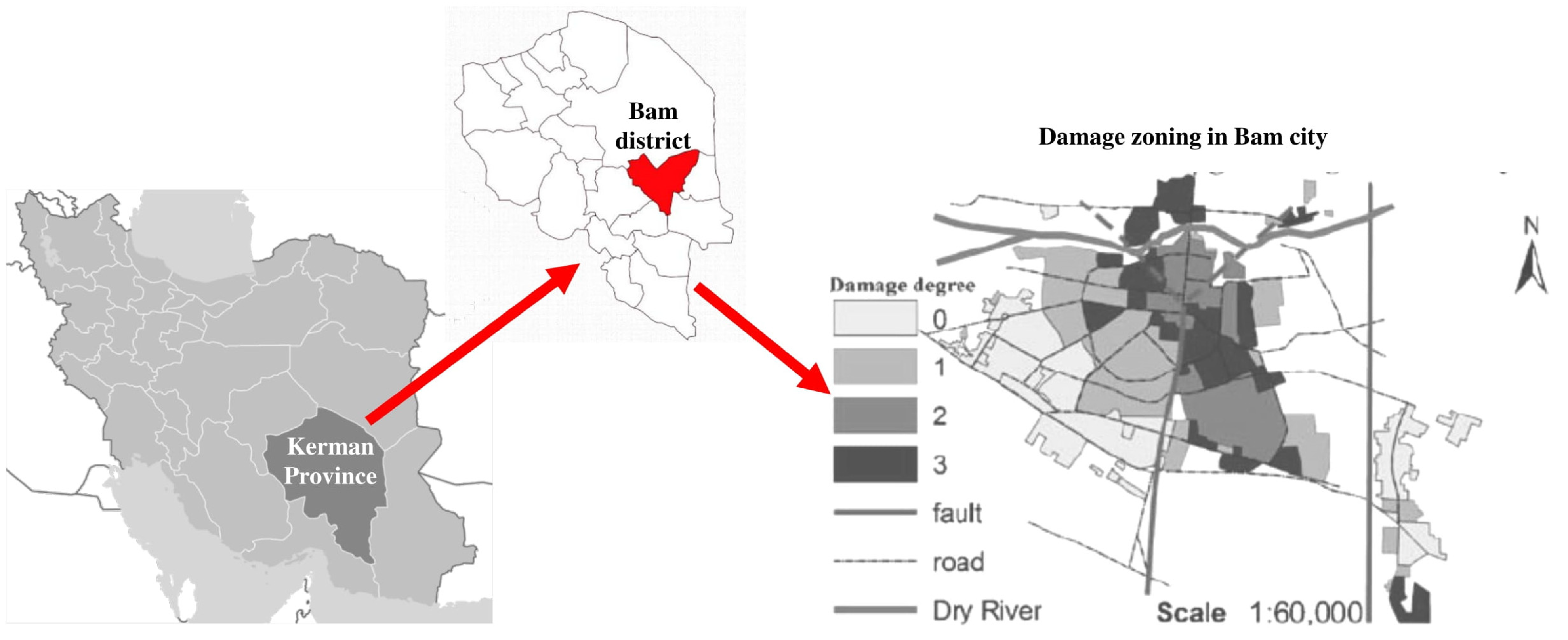

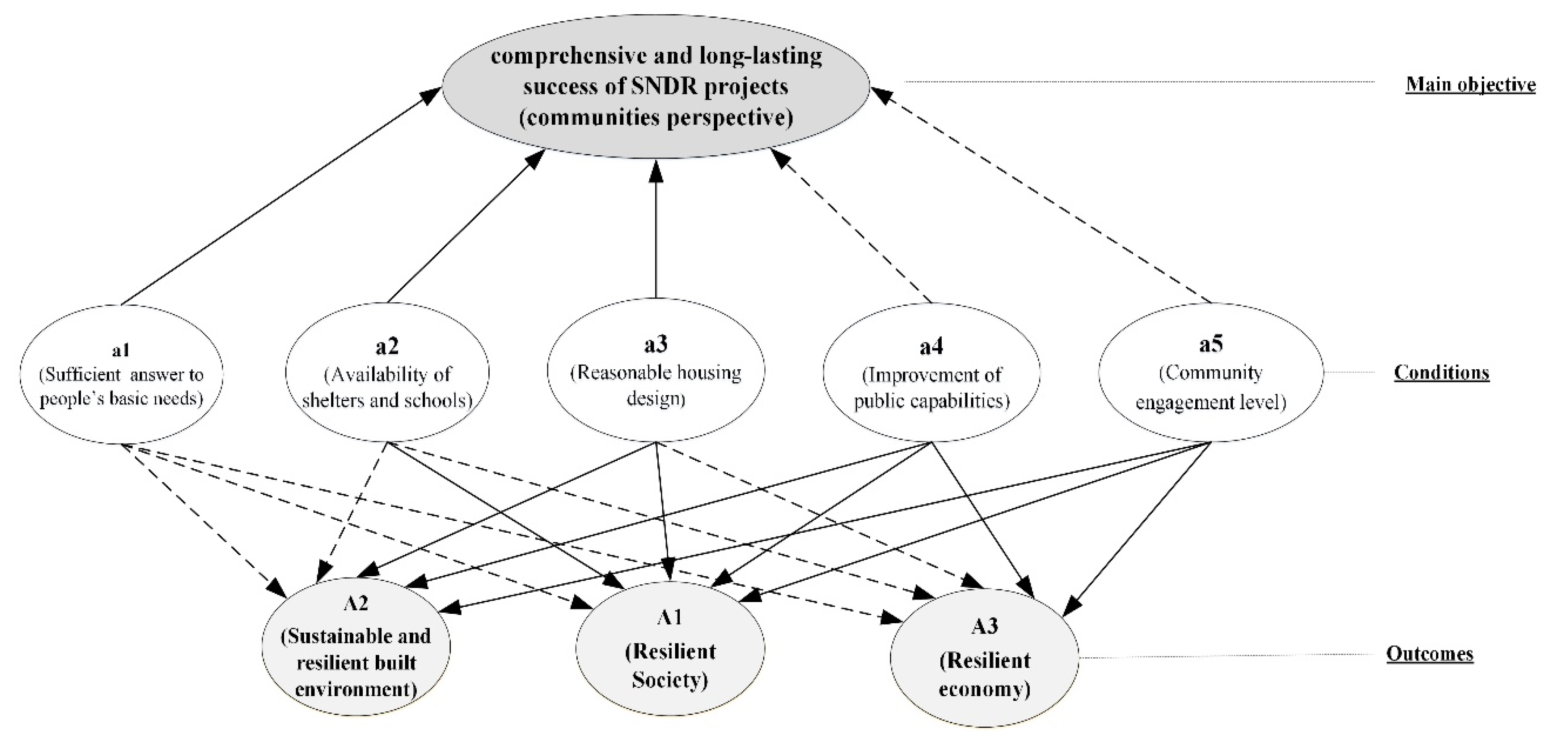

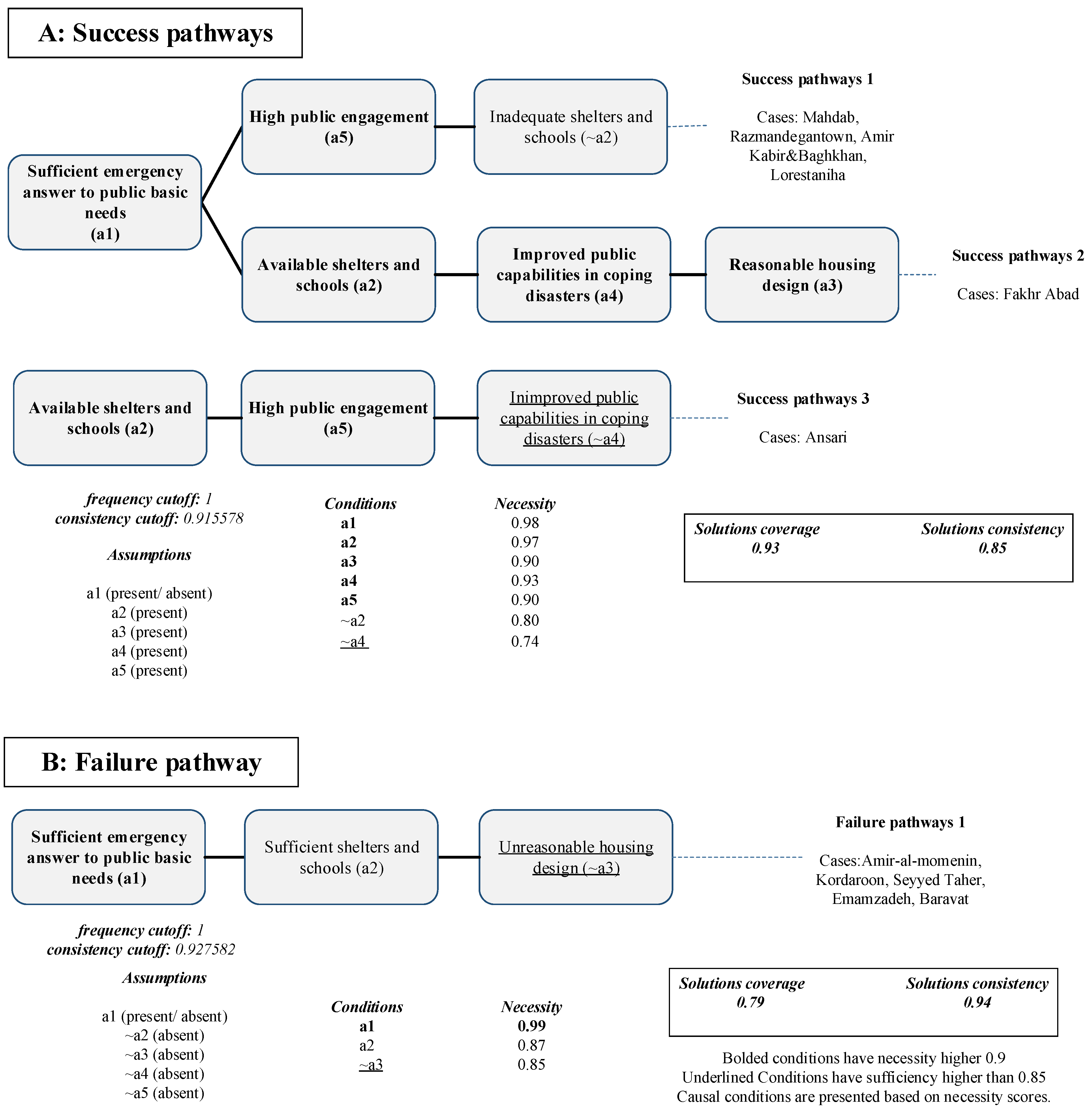
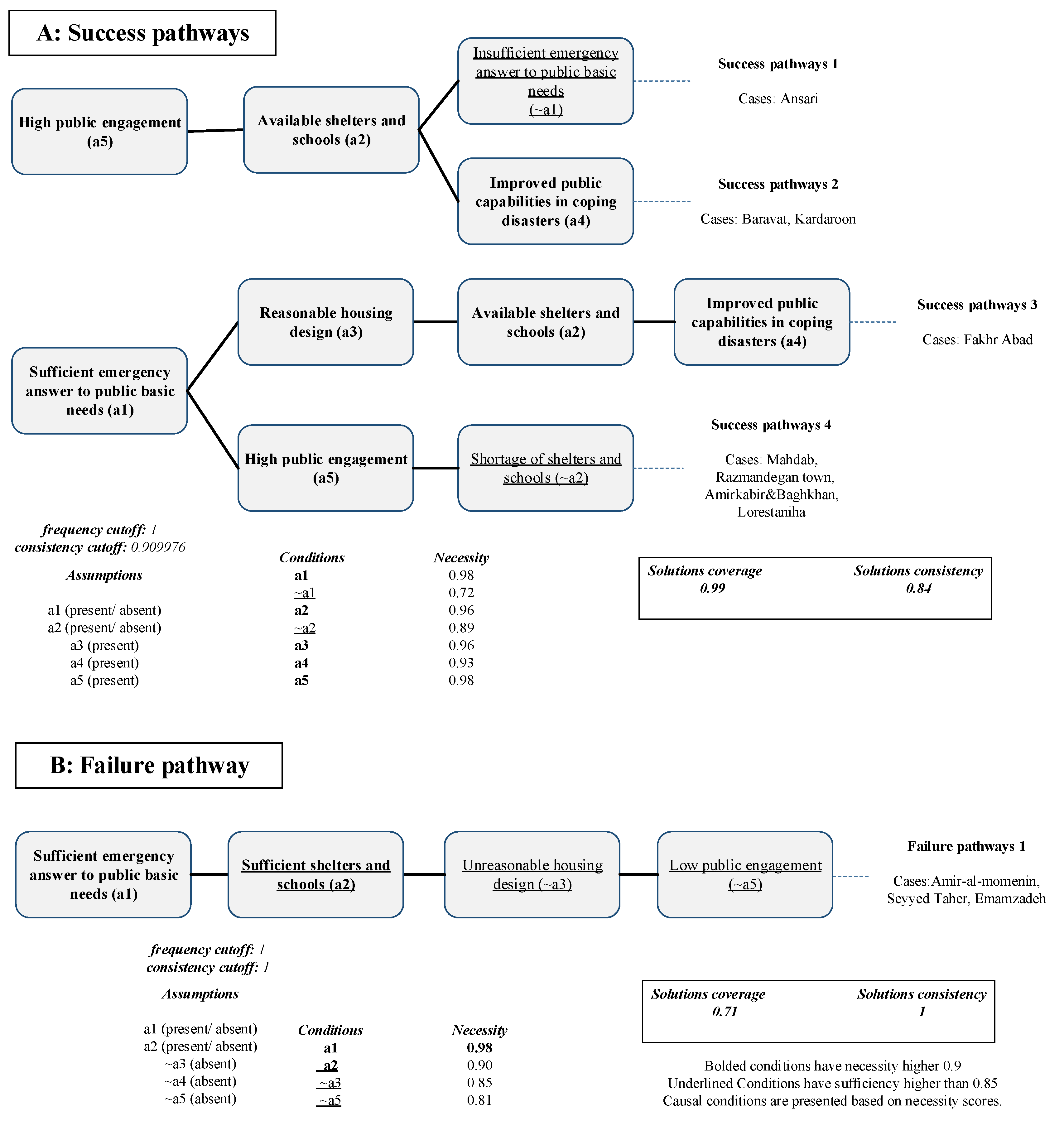
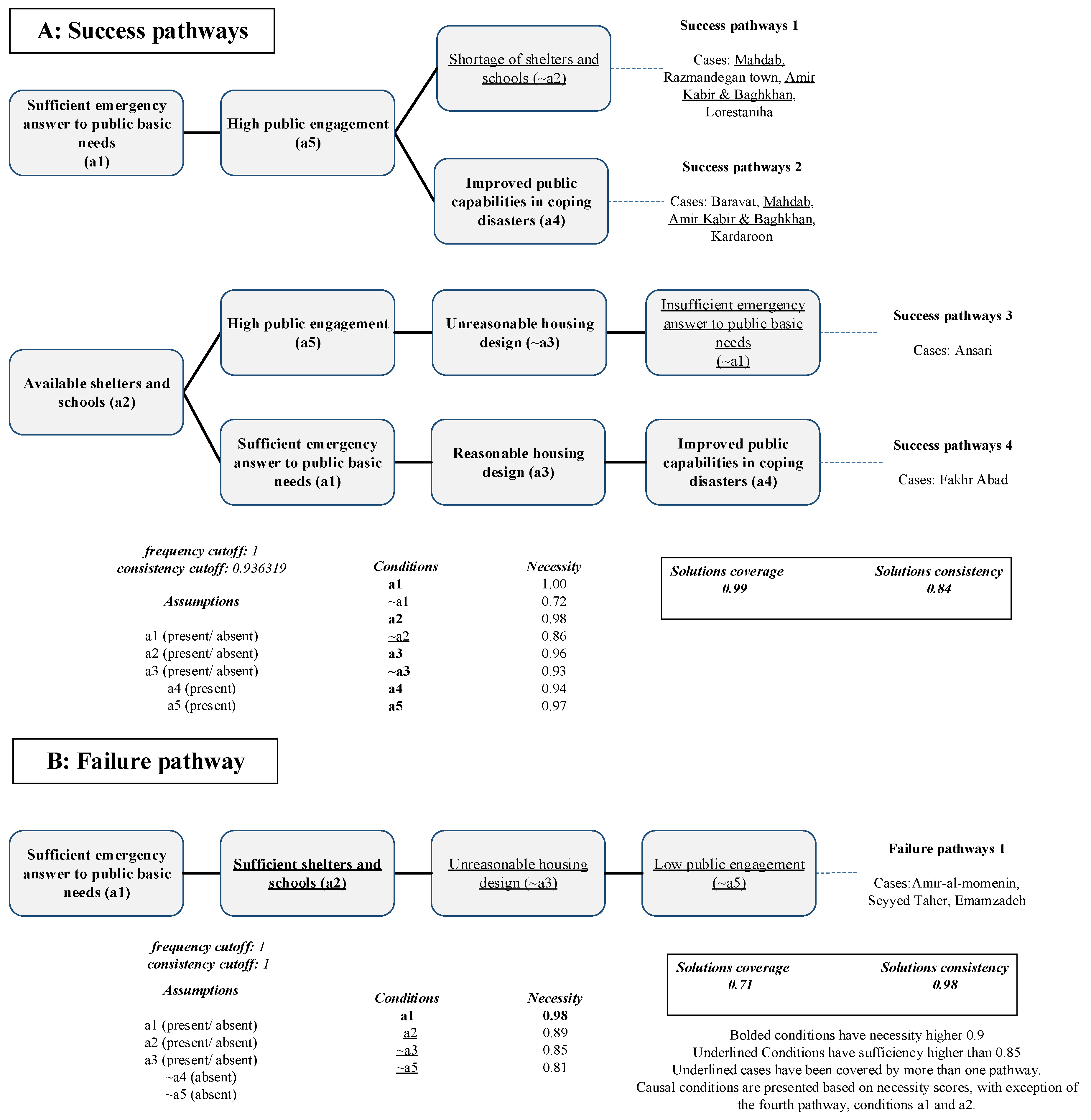
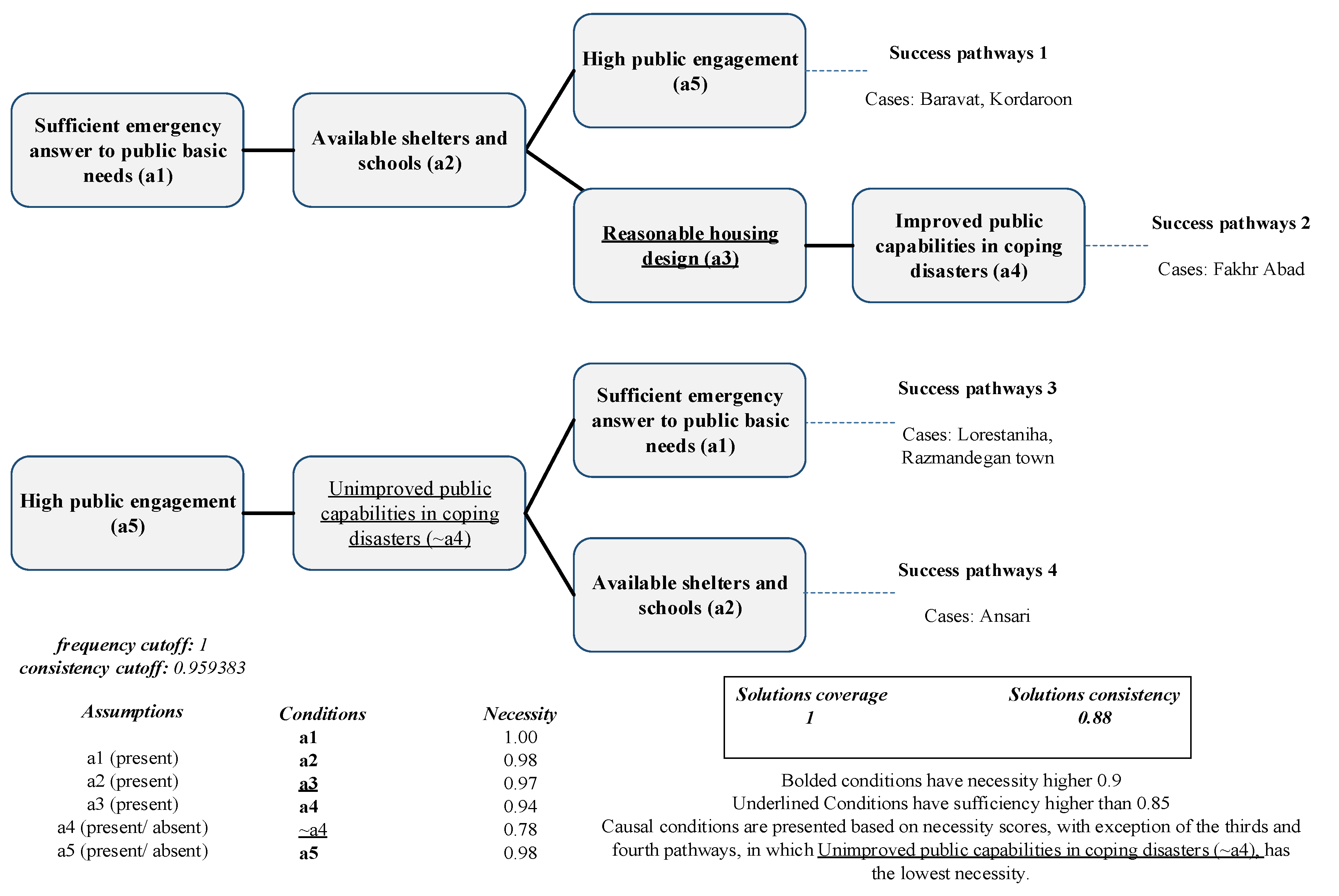
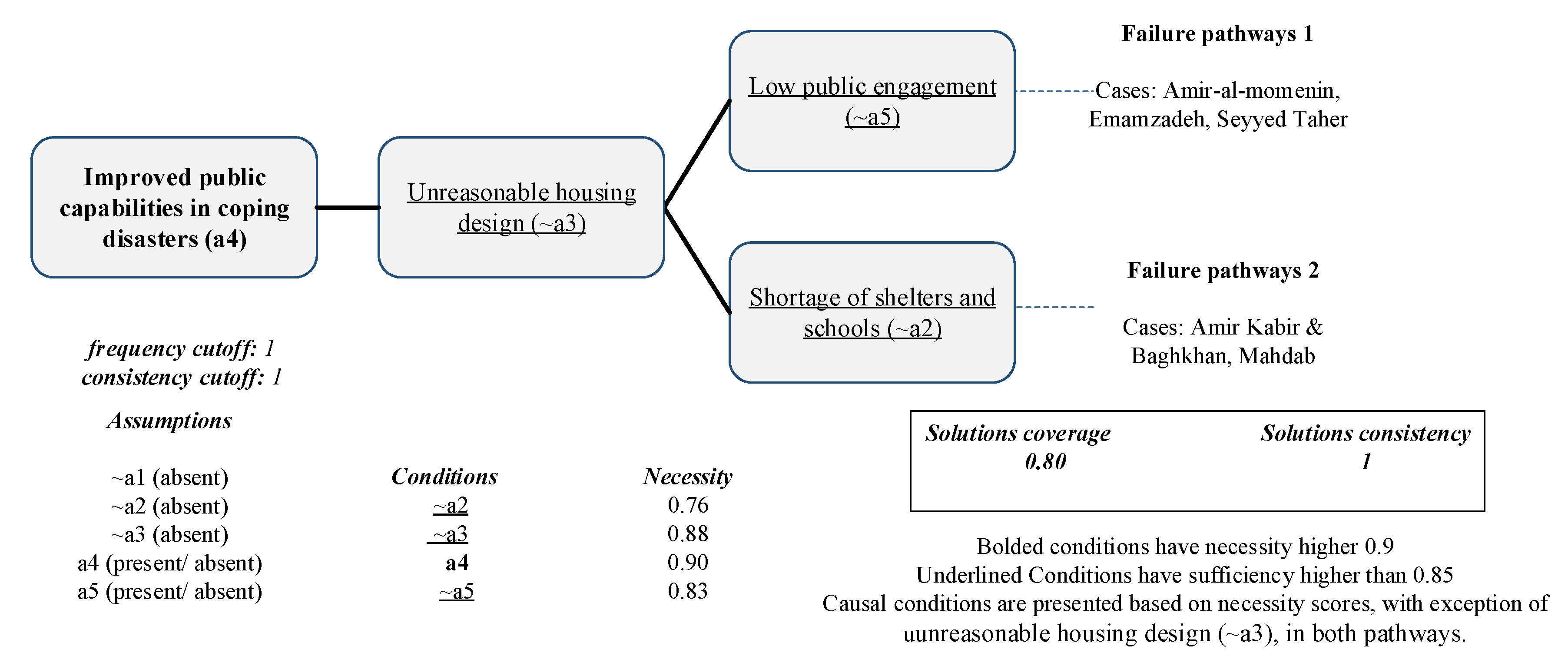
| No | Outcome | Delphi Mean Score (from 5) | Indices | Source |
|---|---|---|---|---|
| A1 | Resilient Society | 3.8 | Social connections | [10,14,15,26] |
| Psychological support (suicide, mental disorders report | [13,32,33] | |||
| Safety (criminal behavior) | [14,27,34] | |||
| Life satisfaction and satisfaction of recovery process | [35,36,37] | |||
| A2 | Sustainable and resilient built environment | 3.66 | Population per capita in houses | [13,27,29] |
| Hygiene water accessibility | [19,28,31] | |||
| Electricity accessibility | [19,28,31] | |||
| Road improvement | Case knowledge | |||
| Number of city facilities (schools, hospitals) | Case knowledge | |||
| A3 | Resilient economy | 4.3 | Number of new businesses initiation or restoration of old ones | [32,38,39,40] |
| Employment growth rate | [14,38] | |||
| Household income growth rate | [19], Case knowledge |
| No | Conditions | Indices | Sources |
|---|---|---|---|
| a1 | Sufficient emergency answer to basic public needs * | Sanitation level | [13,37,41] |
| Starting time for rescue and site investigation | [22,42] | ||
| a2 | Availability of shelter and schools * | Shelter availability | [43,44,45] |
| School availability | [15,46] | ||
| a3 | Reasonable housing design ** | Consideration of local culture and community needs | [29,31,47] |
| Consideration of local climate | [32,48] | ||
| a4 | Improvement of public capabilities *** | Disaster and safe construction training | [3,15,49,50] |
| Livelihood development | [51,52] | ||
| a5 | Community engagement level *** | Decision-making | [52,53] |
| Planning | [23,35,54] | ||
| Construction | [23,55] |
| A2 (Sustainable and Resilient Built Environment) | ||||
|---|---|---|---|---|
| Average of B5–B9, with Twice Weight Given to B6 and B7 | ||||
| B5, Population Per Capita in Houses | B6, Hygiene Water Accessibility | B7, Electricity Accessibility | ||
| (B5-1) Changes of the available housing area for each person before and after the earthquake: 0 Decrease in the available housing area for each person 1 Increase in the available housing area for each person | (B6-1) Resuming time of the water availability in the neighborhood: 0 More than two years 0.4 One–two years 0.8 6 months to one year 1 Less than 6 months | (B7-1) Resuming time of the electricity availability in the neighborhood: 0 More than two years 0.4 One–two years 0.8 6 months to one year 1 Less than 6 months | ||
| B5 = sum of scores of B5-1 | B6 = sum of scores of B6-1 | B7 = sum of scores of B7-1 | ||
| B8, Road Improvement | B9, Education and Hospital Improvement | |||
| (B8-1) Resuming time of the roads in the neighborhood: 0 Some roads have not been finished yet. 0.2 More than three years 0.4 Two-three years 0.7 One–two years 1 Less than one year | (B8-2) Road quality: 0 Extremely worse now 0.2 Worse now 0.4 No change 0.7 Better now 1 Extremely better now | (B8-3) Accessibility to the Province center and nearby cities: 0 It is much difficult now. 0.5 It has not changed. 1 It is much easier now. | (B9-1) Education quality: 0 Extremely worse now 0.2 Worse now 0.4 No change 0.7 Better now 1 Extremely better now | (B9-2) Medical service quality: 0 Extremely worse now 0.2 Worse now 0.4 No change 0.7 Better now 1 Extremely better now |
| B8 = minimum of B8-1, B8-2, B8-3 | B9 = average of B9-1 and B9-2 | |||
| Case Num | Case Name | a1 | a2 | a3 | a4 | a5 | A1 | A2 | A3 | ULTIMATE |
|---|---|---|---|---|---|---|---|---|---|---|
| 1 | Amir Kabir & Baghkhan | 0.820 | 0.436 | 0.49 | 0.729 | 0.522 | 0.43 | 0.44 | 0.42 | 0.428 |
| 2 | Mahdab | 0.724 | 0.286 | 0.426 | 0.528 | 0.556 | 0.37 | 0.42 | 0.38 | 0.386 |
| 3 | Fakhr Abad | 0.750 | 0.642 | 0.509 | 0.881 | 0.411 | 0.61 | 0.44 | 0.47 | 0.498 |
| 4 | Razmandegan town | 0.716 | 0.411 | 0.871 | 0.498 | 0.556 | 0.44 | 0.47 | 0.38 | 0.418 |
| 5 | Emamzadeh | 0.814 | 0.665 | 0.474 | 0.539 | 0.444 | 0.47 | 0.43 | 0.42 | 0.436 |
| 6 | Amir-al-momemnin | 0.593 | 0.805 | 0.398 | 0.639 | 0.389 | 0.63 | 0.28 | 0.34 | 0.396 |
| 7 | Lorestaniha | 0.575 | 0.480 | 0.432 | 0.432 | 0.647 | 0.49 | 0.47 | 0.5 | 0.488 |
| 8 | Koradoon | 0.667 | 0.676 | 0.492 | 0.799 | 0.520 | 0.34 | 0.43 | 0.59 | 0.488 |
| 9 | Ansari | 0.477 | 0.580 | 0.409 | 0.250 | 0.791 | 0.52 | 0.54 | 0.46 | 0.494 |
| 10 | Baravat | 0.650 | 0.640 | 0.492 | 0.796 | 0.556 | 0.44 | 0.34 | 0.39 | 0.390 |
| 11 | Seyyed Taher | 0.651 | 0.589 | 0.444 | 0.527 | 0.417 | 0.32 | 0.46 | 0.41 | 0.400 |
| Neighbrhood Name/Condition | a1 | a2 | a3 | a4 | a5 | Ultimate Outcome |
|---|---|---|---|---|---|---|
| Kardaroon, Baravet | 1 | 1 | 0 | 1 | 1 | 1 |
| Emamzageh, Amir-al-momenin, Seyyed Taher | 1 | 1 | 0 | 1 | 0 | 0 |
Publisher’s Note: MDPI stays neutral with regard to jurisdictional claims in published maps and institutional affiliations. |
© 2022 by the authors. Licensee MDPI, Basel, Switzerland. This article is an open access article distributed under the terms and conditions of the Creative Commons Attribution (CC BY) license (https://creativecommons.org/licenses/by/4.0/).
Share and Cite
Bahmani, H.; Zhang, W. Why Do Communities Recover Differently after Socio-Natural Disasters? Pathways to Comprehensive Success of Recovery Projects Based on Bam’s (Iran) Neighborhoods’ Perspective. Int. J. Environ. Res. Public Health 2022, 19, 678. https://doi.org/10.3390/ijerph19020678
Bahmani H, Zhang W. Why Do Communities Recover Differently after Socio-Natural Disasters? Pathways to Comprehensive Success of Recovery Projects Based on Bam’s (Iran) Neighborhoods’ Perspective. International Journal of Environmental Research and Public Health. 2022; 19(2):678. https://doi.org/10.3390/ijerph19020678
Chicago/Turabian StyleBahmani, Homa, and Wei Zhang. 2022. "Why Do Communities Recover Differently after Socio-Natural Disasters? Pathways to Comprehensive Success of Recovery Projects Based on Bam’s (Iran) Neighborhoods’ Perspective" International Journal of Environmental Research and Public Health 19, no. 2: 678. https://doi.org/10.3390/ijerph19020678
APA StyleBahmani, H., & Zhang, W. (2022). Why Do Communities Recover Differently after Socio-Natural Disasters? Pathways to Comprehensive Success of Recovery Projects Based on Bam’s (Iran) Neighborhoods’ Perspective. International Journal of Environmental Research and Public Health, 19(2), 678. https://doi.org/10.3390/ijerph19020678






